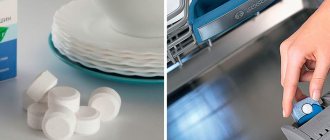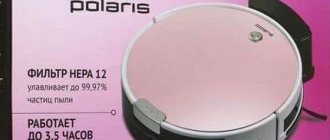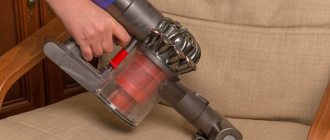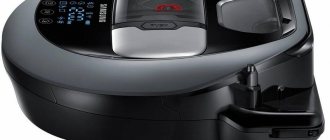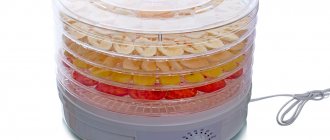Washing vacuum cleaners with water filters appeared relatively recently and quickly became popular. The reason for this is that this type of equipment is an indispensable assistant for those who love impeccable cleanliness. In addition, a washing vacuum cleaner can make life much easier for people suffering from allergies.
The device’s aquafilters trap the smallest particles of dust and allergens in water, thereby cleaning not only the floor surface, but also the air. However, equipment maintenance has its own peculiarities.
Role in operating a washing vacuum cleaner
In order for the equipment to work correctly and last a long time, you need to use a defoamer - a means that prevents foaming in the water reservoir of the device.
A defoamer is a product that contains chemical components that suppress the formation of foam. Initially, it may seem that there is no point in it, because why prevent the water from foaming if it does not bother anyone.
However, everything is not so simple. During operation of the washing vacuum cleaner, under the influence of continuous circulation of air masses, the foam increases in volume and can get into the motor filter. Its main function is to protect the equipment engine from dust. Getting the filter wet leads to a decrease in the quality of air purification.
Getting your engine filter wet is not the worst thing that can happen. Foam getting into the motor of a washing vacuum cleaner will lead to its failure. Moreover, in this situation, repairs are often powerless: as a result, the equipment ceases to function forever.
A defoamer can prevent these problems from occurring.
It performs a number of functions:
- Engine foam protection.
- Maintaining efficient filter operation.
- Improving the performance and suction capacity of equipment.
Preparing the device and using it
You need to know how to use a washing vacuum cleaner correctly. To properly prepare for work, follow these steps:
- Pour water into the container up to the marked mark. Add cleaning agent if desired.
- Combine the capillary tube with the pipe and the water container.
- Select the required nozzle, secure it and make sure that water supply is possible.
- Turn on the power by first plugging the plug into the socket.
Disassembling the vacuum cleaner after work is almost identical, only in the reverse order. Instead of filling the vessel, it should be emptied and washed. Separate all parts and dry.
Washing floors
The vacuum cleaner wets the surface, cleans the floor with the solution, and then sucks the mixture of water and dirt back up. With high efficiency, the floor dries within a few minutes after finishing wet cleaning. If the washing liquid becomes contaminated and cleaning is no longer effective, it is easy to stop the work and replace the water with clean water. This is done at any necessary time.
Attention!
Apartments with laminate flooring should use a vacuum cleaner carefully. Certain types are coated with a water-repellent or protective layer during production: for example, class 32, 33
If the laminate is not protected, it cannot be cleaned. Even varnished types cannot be washed more than 2 times a week, and all alkaline products are especially prohibited.
Carpet cleaning
First, prepare a special shampoo for washing carpet surfaces. You can mix it at home or buy a ready-made sample. However, before you wash your carpet, you need to vacuum it as usual.
Types of foam neutralizers
There are 2 types of agents that prevent the foaming process. During equipment operation, they are used simultaneously with cleaning liquids.
- Organic based
Oils are used to make organic-based defoamers. They are completely harmless to humans and animals, but they are not easy to find in stores. A small number of manufacturers produce organic defoamers and their cost can hardly be called cheap. They work due to the fact that the oils in their composition increase the surface tension of the liquid.
- Silicone based
A large number of companies are engaged in the production of silicone-based chemicals.
It works by destroying the structure of the foam. The technology of its production is relatively simple, and the raw materials have low cost. Expert opinion
Borodina Galina Valerievna
Anti-foaming compounds should not be frozen. This reduces their functional qualities. Inhalation, contact with skin or eyes is also unacceptable.
Despite the fact that they do not contain heavy metals, formaldehydes or other hazardous components, it is important to remember that defoamers are household chemicals. Accordingly, safety precautions must be observed when working with them.
What defoamer do you use?
OrganicSilicon
What should be the strength of the finished mash?
Braga is the source of the fermentation process, where the result of sugar processing by yeast becomes ethyl alcohol. Subject to optimal proportions of water, sugar, yeast and necessary
temperature conditions, the workpiece is capable of containing an average strength of 12%. It is not possible to achieve greater strength in the usual way. This is due to the fact that as the concentration of alcohol increases, yeast begins to process it. Ethyl is a toxic product, which contributes to the death of yeast microorganisms. Therefore, when a certain concentration of alcohol in the mash is reached, the fermentation process stops.
If the product has a lower degree, but by all indications the raw material is already ready for processing, then two things may be the reason for this:
- there was not enough sugar in the raw materials;
- temperature not met.
Both reasons are easy to fix. It is necessary to re-add sugar and yeast in the required quantity, and place the container with the mash in a warmer place.
Rating of the best defoamers
Products designed to suppress foam formation can be purchased both in online stores and in household chemical supermarkets. There is no need to buy chemicals from the same brand as the washing vacuum cleaner. As a rule, foam suppressants are universal and suitable for all types of equipment with aqua filters.
The list of the best anti-foaming compounds includes both local and foreign manufacturers. The rating is based on data on the demand for a certain type of product.
FoamStop Fructasia from Karcher
The German brand Karcher follows innovations in the field of cleaning technology.
Pros:
- Economical - one 125 ml bottle is enough for about 70 cleanings. For 2 liters of water you need only 2 ml of FoamStop Fructasia.
- Hypoallergenic - suitable for people prone to allergic reactions.
- Pleasant aroma - has an unobtrusive citrus scent.
- Versatility - suitable for all types of equipment with an aqua filter.
Minuses:
- High price - one bottle of FoamStop Fructasia will cost 500-700 rubles.
Huber Schaumstopp
Huber Schaumstopp helps the equipment maintain its dust suction power at a high level.
Pros:
- Released in two volumes - 1 l. and 125 ml.
- Safety - environmental friendliness of Huber Schaumstopp is confirmed by certificates of conformity.
- Low price - volume 1 liter. costs about 1600 rubles, and a volume of 125 m. - approximately 250 rubles.
Minuses:
- Lack of versatility - Huber Schaumstopp is focused primarily on equipment from Zelmer and Karcher. However, it can also be used for equipment of other brands. It is advisable to consult a specialist on this matter.
Grass Antifoam
The Russian brand Grass produces its own defoamer, which is positioned as a direct analogue of FoamStop Fructasia from Karcher.
Pros:
- Versatility - Grass Antifoam can be used for all types of equipment that require foam suppression.
- Low price - in comparison with the original, Grass Antifoam is several times cheaper. So, a bottle with a volume of 250 ml. will cost 150-300 rubles.
Minuses:
- After use, stains remain on the walls of the water tank. However, this can be easily solved with a damp sponge.
ACG Antifoam
Russian ACG Antifoam is produced by professionals in the field of home care. The brand specializes in the production of chemicals for cleaning companies.
Pros:
- Versatility - ACG Antifoam can be used for all models of washing vacuum cleaners, as well as for other types of equipment with an aqua filter.
- Can be used in conjunction with acid- and alkaline-based washing liquids and does not affect their cleaning ability.
- Low price - 1 liter bottle. costs 200-300 rubles.
Minus:
- Lack of efficiency - 1 liter bottle. will end within 3-4 months of use.
Antifoam Agent from Rein
The Rein company specializes in the production of chemicals for professional home cleaning.
Pros:
- Economical consumption - one 1 liter bottle of Rein Antifoam Agent. enough for one and a half to two years of constant use.
- Increases the cleaning power of acid-base based cleaning liquids.
Minuses:
- High price - 1 liter bottle. costs 600-800 rubles.
- The surfactants in Antifoam Agent may cause allergic reactions in people prone to them.
A few questions about fermenting mash
Many (especially beginners) moonshiners have accumulated questions, which we will try to answer below.
Braga has not been good, is it possible to drive her away?
Of course, it is not advisable to do this, but in case of emergency, it is possible. Use tips to stop fermentation. But a shortage of alcohol is almost certainly guaranteed. Incomplete fermentation means that the sugar has not yet been converted into alcohol.
Carefully. During distillation, foam may be released, which will affect the quality of the product.
In this case, secondary distillation helps.
Why does mash ferment for a long time?
As already noted, there are many factors that influence the duration of ripening.
In addition to the quality of the ingredients, be sure to pay attention to the room temperature. If it is below 18°C, then the vital activity of the yeast is very weak, so the process is sluggish.
Above 30°C, their vital energy also decreases, and at around 40°C they die completely.
In addition, the fermentation tank should not be placed on a cold floor (tile, porcelain tile, stone). There should be a warm base underneath. Otherwise, even if the room is 22°C, the mash may be 16 degrees, which is unacceptable.
What to do if the mash runs away?
The most common causes of increased foaming:
- using baker's yeast instead of alcoholic yeast or accidentally exceeding its quantity;
- adding honey to the wort instead of sugar;
- malt and grain raw materials at the first stage of fermentation can also produce too much foam;
- exceeding the permissible volume for wort.
Please note: the container should be filled with mash to a maximum of 2/3 of its volume. And when using products that can potentially produce a lot of foam - only half.
Is it possible to replace a store-bought one with a homemade one?
There are options for foam suppression compounds that you can make yourself:
- Salt. 2-3 tablespoons of the substance are added to a reservoir of water.
- Vinegar or vinegar essence. In the first case, pour in half a tablespoon, in the second, 2-3 drops are enough.
- Starch added to the equipment tank in the amount of 2-3 tablespoons.
- Sunflower oil in a 1:1 ratio with baking soda. The most controversial option of all home recipes. The fact is that the oil settles on the walls of the tank. It is possible that a small amount of it remains on the floor.
Expert opinion
Borodina Galina Valerievna
If you decide to save money and give preference to homemade foam suppressants, you should remember that their safety for equipment has not been proven. It is possible that in the future they can have a more negative impact on equipment than the foam itself.
How to increase the strength of mash
As already mentioned, the optimal strength that mash can achieve without additional techniques is 12 degrees. To increase this degree, many winemakers add so-called “tails” to the mash. ? This is the last fraction obtained during the distillation of raw materials. This liquid usually contains approximately 20 revolutions, as it is obtained at the highest distillation temperatures. If you pour in “tails”, the strength of the workpiece can reach 22 degrees. But this procedure must be postponed until the distillation begins, that is, we pour it into the finished raw material, otherwise you can kill the yeast and spoil the entire product.
Also, in order to increase the degree of mash, it is necessary to use specialized alcohol or wine yeast. The strength numbers of such a preparation can rise to 18.
You can also artificially increase the strength of the mash by initially adding more sugar. Let's add not 1 kg, but 1.2. But this method does not make it possible to increase the strength by more than 15 degrees, since it is at such readings of the amount of alcohol in the liquid that the yeast stops working and dies.
conclusions
In order for the washing vacuum cleaner to work efficiently and for a long time, it is important to use foam suppressing compounds when working with it. When choosing, first of all, you should pay attention to the nominal volume and efficiency of the composition.
If the bottle is modest in size, this does not mean that it will run out quickly - it all depends on the concentration of the active ingredients in the product, and vice versa.
The use of foam suppression compounds prepared by yourself calls into question the safety of the equipment - you must use them at your own peril and risk.
Technology for preparing mash
To prepare high-quality raw materials for distillation, you must follow simple rules:
- Correct selection of raw materials. An important component for obtaining high-quality moonshine with a pleasant taste is correctly selected products. For example, for a classic recipe for moonshine with sugar you will need: sugar, yeast and water. You should pay special attention to all products. It is better to take spring or bottled water, and specialized yeast - for making alcoholic beverages or wines. If moonshine is made from other products, they must also be of the highest quality.
- Selecting the container in which fermentation will take place. It is better to give preference to glassware, but if there is none, then you need to choose among materials that do not react with alcohol and are suitable for working with food. You should also be careful when handling plastic utensils. No matter how much the market offers high-quality plastic containers, there are still dangerous Chinese counterfeits.
- For high quality raw materials, a water seal is also necessary. This device removes carbon dioxide produced by yeast, while preventing the release of mash and the entry of bacteria and debris into it. If there is no suitable water seal at hand, people use a rubber glove with a hole in one of the fingers. This device also serves as a good sensor for the readiness of raw materials. If the glove no longer inflates and falls off, then everything is ready.
- It is very important to know how long the mash is being prepared. Usually this is a period from 3 to 14 days. It all depends on the products you use. So, with sugar, fermentation occurs in about 7-10, and with other products it can take up to 20.
- An important component is the holding temperature of the product. If it is lower than or equal to 18°C, the fermentation process will stop. A high temperature is considered to be more than 40°C; in this mode, yeast bacteria die. The optimal temperature range is 20-30°C.
- The ratio of products is the most important point in the manufacture of the workpiece. If you prepare mash with sugar, the optimal ratio is 1 kg of sugar, 100 grams of yeast, 3 liters of water. Naturally, there are different points of view on this relationship. The strength of the final result largely depends on how much sugar or other product containing sucrose or fructose is in the preparation.

